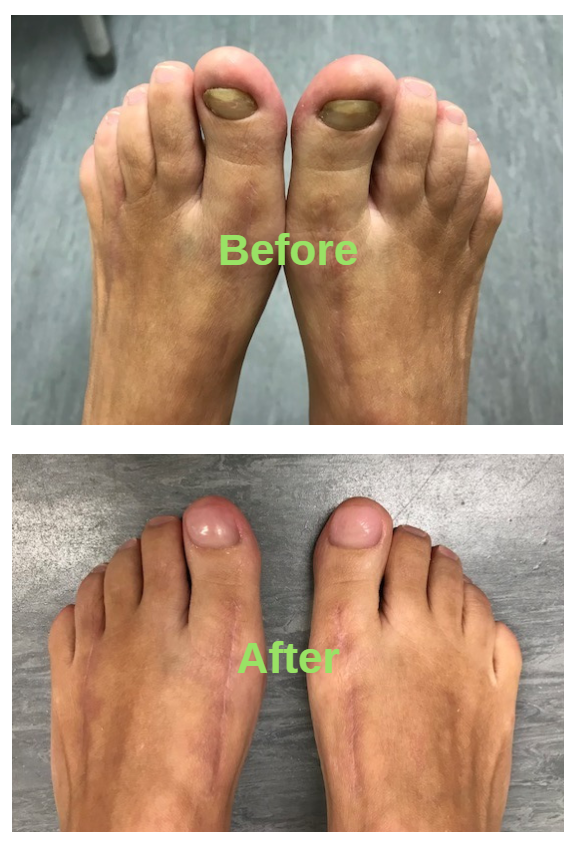Are you unhappy with the look of your toenails? Are they crumbling? Discoloured or damaged from trauma?
Keryflex could be the answer for you!
Written by KIRSTINE MANN – MANAGING DIRECTOR AND SENIOR PODIATRIST & Edited by SOPHIE YOUNG – DIRECTOR AND ENDORSED PODIATRIST
KeryFlex is a unique, medical-grade resin material used to create a natural-looking artificial nail. This procedure is particularly useful for individuals who suffer from discoloured, thickened and distorted nails due to fungal infections, injuries or other nail diseases. Read our comprehensive guide on Keryflex below.
What is Keryflex?
KeryFlex is a flexible, durable, and non-porous material that is used to restore the appearance of damaged or discoloured nails. It is made up of a polymer blend of urethane acrylate and methacrylic acid that is applied to the nail bed and can be shaped and moulded to match the natural nail.
How does Keryflex Work?
The process of applying KeryFlex involves several steps, starting with cleaning and preparing the nail. Afterward, a bonding agent is applied to the nail surface, followed by the KeryFlex resin material. This material is then moulded and shaped to match the natural contour of the nail. Once the desired shape is achieved, a UV light is used to cure the KeryFlex, making it hard and durable.
Who is a good candidate for Keryflex?
Individuals with discoloured, thickened, or distorted nails due to fungal infections, injuries, or other nail diseases are good candidates for KeryFlex. It is also suitable for individuals who are self-conscious about the appearance of their nails and want to improve their overall aesthetic.
How long does it take to apply Keryflex?
The entire process of applying KeryFlex takes around 45 minutes, depending on the extent of damage to the nail or nails. Most individuals only require one application of KeryFlex to achieve the desired result.
Does Keryflex nail restoration treatment hurt?
No, applying KeryFlex is just like getting a pedicure treatment. However, if you have any open wounds or sores on your feet, you may feel some discomfort during the process.
Can I apply nail polish on top of Keryflex?
Yes, you can apply nail polish on top of KeryFlex once it has been applied and cured. However, it is recommended to use a non-acetone-based nail polish remover when you want to remove the polish.
What are the benefits of Keryflex?
KeryFlex provides a natural-looking solution for individuals with damaged or discoloured nails. It is a non-invasive, pain-free procedure that requires no anaesthesia or downtime. It also protects the nail from further damage, allowing it to grow normally.
What are the potential side effects of Keryflex?
KeryFlex is a safe and effective procedure, but there are potential side effects. Some individuals may experience slight sensitivity or irritation following the procedure. In rare cases, the KeryFlex may become dislodged, causing discomfort or pain.
Why is it important to maintain proper nail care?
Proper nail care involves keeping your toenails clean, trimmed and moisturised to prevent infection, ingrown toenails, and other foot problems. Neglecting nail care can lead to serious health issues that can affect not only your feet but your entire body. For example, an infected toenail can spread to other parts of the foot, and if left untreated, can lead to complications such as cellulitis or sepsis. Nail care is also essential for preventing the spread of toenail fungus, which is highly contagious and can cause thick, discoloured, and brittle nails. Therefore, nail care should be an integral part of your overall foot hygiene routine to ensure the health and well-being of your feet.
How much does Keryflex cost?
The cost for a KeryFlex nail restoration treatment will depend on the individual and how many nails need to be restored. Please contact us at reception on 9555 3044 to find out more about pricing.
Where can I get Keryflex nail restoration treatment in Melbourne?
Highett Podiatry offers a range of Podiatry services, including KeryFlex nail restoration treatment, which our podiatrists, Stephanie Carter, Scott Rayment and Sophie Young, are all trained in the Keryflex application.
If you’re interested in getting KeryFlex treatment in Melbourne, contact us on 9555 3044 to schedule a consultation with one of our experienced podiatrists, who can assess your condition and recommend the right course of treatment for your needs.
What do you think I should consider before the Keryflex application?
- You need to have at least 30% of your existing nail attached to the nail bed to optimise adherence and longevity.
- It should not be used if you have an active ingrown toenail.
What if I am treating my nails for fungus?
Oral treatments for fungal nail infections can still be used when you have Keryflex on your nails. Unfortunately, topical nail treatments can not be used. We would advise against leaving Keryflex on your nails for long periods if trying to treat a nail fungus as it will stop the nail’s ability to breathe; however, it can be used for short durations to improve the appearance of your nail for a special occasion or event.
How long does it take to apply Keryflex?
It typically takes about 15-30 minutes to complete the application of Keryflex bonding agent, resin and sealant as well as UV light curing. Of course, this depends on the number of nails being reconstructed.
After Keryflex is applied, How soon must an individual return for another application?
While the answer depends on the individual, the average time between applications is 6 to 8 weeks.
Can restoration be done on a toe with no natural nail?
Because Keryflex doesn’t bind to skin, it recommended that at least 15% of the natural nail is present for reconstruction.
How is a Keryflex Nail removed?
Because Keryflex nail is bonded to the natural nail, it can be filed off using an electric drill until it is no longer attached to the nail.
Who should not use Keryflex?
KeryFlex should not be used on individuals with peripheral vascular disease, arterial insufficiency, peripheral neuropathy, suspicious pigmented lesions on the nail or in-grown toenails. It should be avoided in patients who are pregnant, nursing or known to be sensitive or allergic to any of its ingredients.
Are there any other precautions individuals should be aware of prior to a Keryflex procedure?
It is recommended that you refrain from using any products on the natural nail 2 days prior to a KeryFlex procedure.
Is Keryflex a cure for fungal nails?
No. KeryFlex is a purely aesthetic procedure.
How does a Keryflex nail differ from an acrylic nail?
Acrylic nails are rigid and do not bend with the natural movement of the toes. As a result, acrylic nails applied to the toenails can cause damage to the layer of tissue under the nail (nail bed). Acrylic nails are also applied using strong acids which irritate the nail bed and can further damage the existing nail.
Inversely, KeryFlex is flexible, yet durable, and designed specifically for the toes. It’s also free of harsh acids used in salon systems, non-porous and will not allow moisture to permeate and get between the natural and prosthetic nails.
Can Keryflex be trimmed by regular nail trimmers of do patients have to return to a foot care provider for professional trimming?
Do not cut or clip a Keryflex nail. It should only be filed with a nail file or emery board to maintain a normal length.
Can Keryflex be used in combination with topical antifungal treatments?
Yes. While KeryFlex is not a treatment for fungal nails, a topical antifungal may be applied around the cuticle area. However, application of any liquid products under the proximal tip should be avoided.
Can Keryflex be used in combination with laser therapy?
Yes. While it is not recommended to laser through a KeryFlex nail, a KeryFlex nail may be applied immediately after laser therapy and in between treatments.
Will continued exposure to the sun wearing open toe shoes lighten or weaken a Keryflex nail?
No. KeryFlex has been formulated with ingredients to protect against potential sun damage and yellowing.
Are there any prohibitive footwear choices not recommended after applying Keryflex?
Comfortable & properly fit shoes are recommended because friction against shoes may cause a KeryFlex nail to chip, crack and reduce its overall integrity.
Any questions? Give our friendly reception team a call at 9555 3044, and we can answer any questions you may have.


